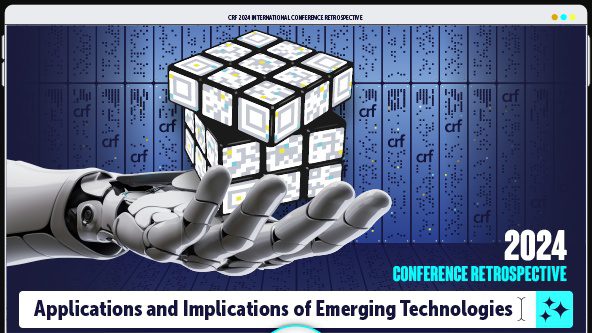AI and Technology
Blog: The Top 5 Near-Future Technologies – and What They Mean for Your Business

Sørensen, Reader (Associate Professor) in Digital Innovation within the Department of Management, LSE
What will help you bring your business into the Digital Value Era?
In an entry in a Briefing Paper for HR Directors, Dr Sørensen outlined some key technological innovations on the business horizon.
Digital transformation is a significant challenge for organisations – and one that falls heavily on the shoulders of HR.
It would have been challenging to predict precisely how disruptive for most office work the pandemic would be. As it turned out, the technicalities of virtualising information work proved relatively easy to resolve, even if their long-term viability is unclear. That said, being physically together at work can be critically important and have a significant positive impact on wellbeing.
Many now hope for a future of work with the best of both worlds – a better work/ life balance, working together in the same place when it makes a difference, and less reliance on means of commuting and transportation.
The strength of the current Digital Platform Era is precisely the increasingly ready availability of the foundations for the constant wave of digital transformation. However, the subsequent waves of digital challenges cannot be met by individual single-firm controlled digital platforms (Uber, Air BnB, etc.) alone. The global digital mega-platforms do not collaborate, and future digital transformations require precisely this.
The Digital Platform Era
On today’s Internet, digital platforms serve the purpose of trustworthy mediators of matchmaking for digital content, goods, and services – for example, people needing a ride and Uber drivers needing jobs.
The digital platforms also streamline this through a centralised, searchable index. As a result, the platform facilitates new kinds of service relationships and controls all the resulting transactional data. The dynamics of these digitally-enabled multisided markets have quickly created winners and losers, resulting in highly centralised market power – especially with personal data.
However, this centralised wholesale hoarding of data and creation of hidden algorithmic nudging of our behaviour has come to public attention. While it may seem impossible to live without the services provided through this harvesting of data, the public and political debate is becoming increasingly hostile to these business practices. Not only do we need new ways of addressing such challenges, but we are also facing five major categories of technologies that further exacerbate the need to address them.
- The ‘Internet of Things’: 5G telecommunications and the Internet of Things connected through this infrastructure. This category of technology enables digital connections beyond mobile phones — all matters of physical devices, machinery, and fixed installations.
- AI: Artificial intelligence supporting the automatic detection of patterns and the resulting creation of new algorithmic behaviours.
- Autonomy: Various forms of autonomy allowing self-guided vehicles, drones, and robots to traverse geographies and buildings without precise pre-determined maps but instead by plotting a viable path by navigating environmental data.
- Hybridity: Extensive mapping of the digital and the physical, for example, through digital twins. A digital representation can enable highly flexible representations and adjustments of physical goods. Lego has used this for several years in their augmented reality catalogues.
- Blockchain: This category of technology supports peer-based exchanges of scarce digital objects, such as digital money, certificates, deeds, without the need for a central platform company gaining exclusive ownership of the transaction. TradeLens supports container supply-chain companies managing critical documents more effectively with a blockchain as the collaborating organisations agree on collectively verifying who is currently in possession of what valuable shipping document.
The Digital Value Era
So, when it comes to these five, what do we need to consider?
Under the current approach, a centralised digital platform would constitute a barrier to innovation. It would require collaborating organisations to relinquish all control over their transaction data.
The significant complexity in the virtual-physical interrelationships across the five techonologies above will unlikely be mastered by one organisation. This implies a competitive premium on firms working together to leverage these essential technologies to shape new business models.
This will represent a Digital Value Era of collectively agreed decentralised peer-to-peer exchange of scarce digital objects. There is no necessity of a central platform firm acting as a matchmaker.
What does that look like?
Smart contracts could govern inter-organisational exchanges. Or a musician will be able to flexibly track the use of a song and automatically get royalty payments when someone decides to use it, depending on how it is used.
So, where does HR fit into all this?
The purpose of many of these technologies is to reduce risk: blockchain decentralises key information, making physical IT infrastructure less vulnerable, for example, and autonomous AI optimise decision-making and reduce the risk of human error.
Less risk means less issues of security or data breaches for HR to take care of. It also offers HR professionals a wealth of new ways to collect, read and interpret data on both internal and external concerns.
The Digital Value Era will support flexible business models involving multiple organisations that up-front decide the principles for how they will conduct exchanges and what data will be available to all. Consider it a modern-day cooperative movement enabled by digital technologies.
Read more from this Briefing Paper:
HRD Briefing Paper: Scanning the Horizon: Trends and Issues in 2022
UPCOMING CRF CONFERENCE:
Trading in the New
Business Landscape
Featuring Tom Standage, The Economist, delivering The Technology Challenge




